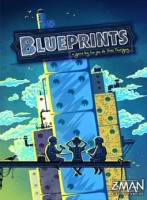
Blueprints
Overview
Players are competing in an architectural contest. Over a series of three rounds each player is challenged to build a structure according to their specific blueprint using only six dice (of four different building material types). The player whose structure scores the most points receives awards. Special prizes can also be scored for building specific dice patterns. After three rounds the player who scores the most points from Awards and Prizes is declared the master builder!
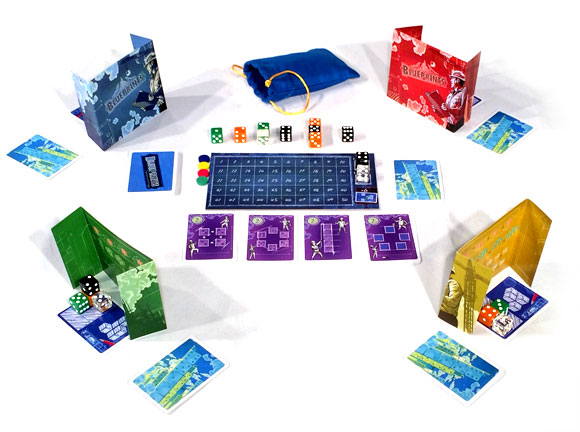
The Dice and Scoring
Architects need to understand their building materials and just how each contributes to the form and function of their creations. The building materials you use for the game are dice! There are four different types which are key to you building the highest scoring structure possible and each has a specific scoring attribute:
- Glass (clear): Each Glass die in your structure scores a number of points equal to its face value.
- Wood (orange): Each Wood die in your structure scores 2 points for each other die that is adjacent to it.
- Stone (black): Each Stone die in your structure scores a number of points depending on the level of the building it’s on. A Stone die on the ground floor scores 2 points, second floor scores 3, third floor scores 5 and all floors above that score 8 points.
- Recycled (green): The Recycled die is worth a number points depending on the total number of recycled dice in your structure. The more you use, the higher the score. Only one green die in your structure is worth 2 points. But manage to make your building entirely green (get it?) and you score a whopping 30 points!
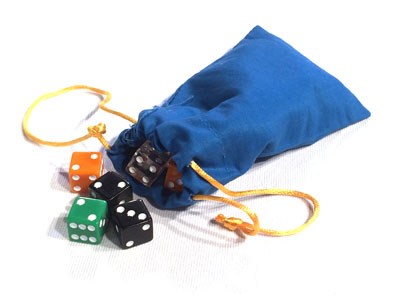
Get ready!
All 32 dice are placed in a bag and a number of dice are drawn and rolled depending on the number of players. This becomes the pool of available building materials. The scoring track is set up with each player’s matching score markers. Two additional dice are drawn and placed on the “in demand” spaces in the upper right of the scoring track and will break any ties should they occur. Finally, the deck of Blueprint cards is shuffled and one random Blueprint card is dealt to each player face down. Blueprint cards are placed face up behind their player screen so other players can’t see your creation. Let the competition begin!
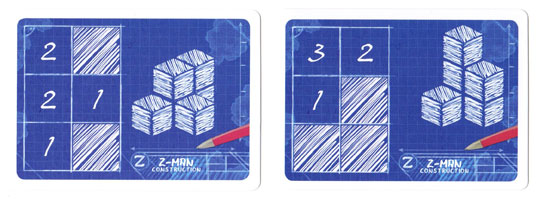
The Game Round
A player turn is comprised of one phase. Yup…one: Build. Simply select one die from the available materials, keep its facing the same and place it on your Blueprint card.
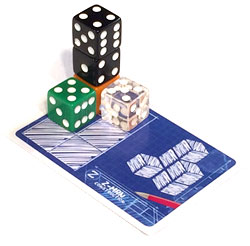
Check out a sample Blueprint card above. It shows a specific design that you may (or may not) want to follow. The die you choose in the Build step may be placed on an empty space on the card, or on top of an already placed die as long as its value is equal to or higher than the die below it. Oh, and you can’t place dice on the scratched out spaces.
Once a die is placed, you draw a die from the dice bag, roll it and place it with the other available materials. Boom, you’re done. The next player can build.
After all players have drawn and placed six dice, players reveal their buildings and score them in turn based on the type of building materials used. In addition, if a player followed their blueprint exactly they score a Blueprint Bonus of 6 points. Mark each player’s score on the track. But the scoring doesn’t stop there.
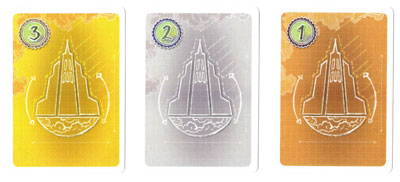
The player with the highest score receives the highest valued award card. (For 4 players it’s Gold and is worth 3 points. The player with the next highest score receives the Silver, and so forth.) These are placed face down next to the player that earned them.
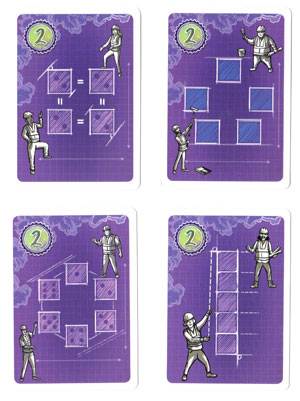
Next, Prizes are awarded. Prize cards are earned by having a specific combination of dice in your building. Only one of each type may be earned in a round and each is worth 2 bonus points. There are four types of prizes:
- The Skyscraper Prize: Having a building of level 5 or higher.
- The Structural Integrity Prize: having a building that has 4 or more dice of the same value.
- The Geometer’s Prize: Having a building that includes dice with all values (1-6).
- The Materials Prize: Having a building that includes 5 or 6 dice of the same building material (color).
Prize cards are also placed face down next to each player that earned them and the round ends. Return all dice to the bag, discard the old Blueprint card and remove the scoring markers from the scoring track. Then begin the next round.
Game over…
Once the players complete scoring on the third round, all players flip over their Award and prize cards to determine the winner.
Components
Philippe Guérin and Chris Quilliams have given this game a nice feel. Opting not to use bright vibrant over produced graphics, the whole game has a “blueprint” feel, light colored lines on a blue background with some scripted fonts. Nice. The cards and dice are high quality. It would be nice if the player shields and the dice bag were a bit bigger. The standard sized d6s barely fit in the bag and your building just barely fits behind your screen, but they are still functional.
Who would enjoy this game?
Final Thoughts
Dice games have become a mainstay of the hobby games industry recently. In addition, dice versions of many games are continuing to pour out. And those that succeed are usually those in which the dice are used in a unique way. And so it is with Blueprints. Here you have several aspects coming together in perfect synchronicity with such elegance that you can’t help but admire its construction – just as you would a Frank Lloyd Wright home.
The first of these is the use of three elements to product scoring opportunities: the available materials, the blueprint card and 4 building materials’ scoring attributes. These provide many thousands of combinations and puzzle-like, head-scratching moments as you attempt to make the perfect placement. One can see that designer Yves Touigny used this as the foundation of the game. (Get it?) But even more, these three elements are fused so seamlessly into a mechanic that it’s not clunky or complicated. You know it’s a great game when you don’t feel like the game is playing you; rather you are in control, and have the pleasure/challenge of choice.
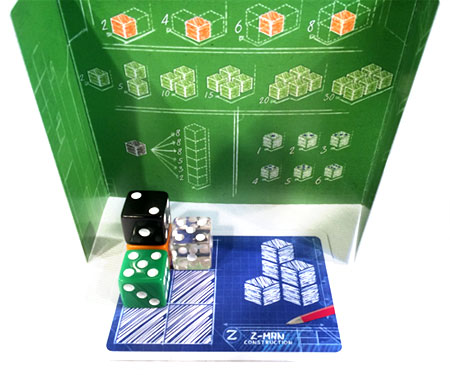
Next, points aren’t cumulative. With three different building opportunities or rounds, there isn’t an overall score that allows for one player to pull far ahead of the others. The scoring track resets after each round and only the Award cards remain. With Gold, Silver and Bronze Awards, all but one player scores, and the point spread is kept tight. (So tight that tie breaker dice are required). At first this may seem counterproductive or unfair. (In one game, I witnessed my son win each round with the highest score, and not win the game.) This was because he didn’t strive for the prize cards: the next level that differentiates Blueprints’ scoring.
The Prize cards add another level and strategic element to planning and executing your blueprint. To be competitive, you must coordinate the elements mentioned above with one (or more) of the criteria for earning a Prize. They are all worth two points – but again, the point spread is very tight with games ending in a points spread like 12 to 10 to 9, two points are enough to put you on top. The fact that the Awards and Prize cards are face down also provides a great end-game tension as scores are revealed. Perfect.
Lastly – the Blueprint bonus of 6 points is awarded to you if you follow your blueprint. But at times it may be better to forsake the blueprint if a higher scoring possibility exists.
What an amazing surprise! Blueprints is one of the best light/dice games of 2013. It ticks so many boxes: fast, challenging, competitive, ingenious. It is at its essence a puzzle game. It creates an unbiased and level gameplay experience where players are always within one die placement of winning. It is best with 3 or 4 players – although there are special rules for a two player game. If game design is an art form, and can be judged like architecture, then Blueprints has the form and functional, technical, social, environmental and aesthetic attributes that make it a work of art.
User Reviews (6)
Add a Review for "Blueprints"
You must be logged in to add a review.


You’re rolling and stacking dice? Is this a dexterity game, or made for kids? These are some of the comments that have come up while playing Blueprints, and I can’t say I didn’t initially feel the same way. Blueprints, from just looking at the components (some cards, folded screens, a score track that doesn’t count your score, and dice) was completely off my radar. I’m very pleased that I got pulled into a game at a convention, and have had the chance to play more since!
Goal of the Game
Over three rounds, you want to build the most valuable buildings using randomly assigned building cards (blueprints), and four types of resources: wood, glass, stone, and recycle material represented by the differently colored dice. You are not required to follow your blueprint, but there is a bonus if you do. Each turn the buildings will be scored, with medals awarded to the most valuable. There are some bonus prizes that are also awarded if you meet certain requirements based on dice quantities, types, or arrangements.
Surprising to many I’ve played with, it is not the value of your buildings that will bring victory, but the medals and bonus cards, which are the only victory points in the game.
How to Build Your Way to Victory
In each of the three rounds, play will pass around the table six times. On your turn, you’ll take one die from the face up pool of your choice and place it on your blueprint card. The color of die (type of resource) will determine how that die will score at the end of the round. You place your chosen die on your blueprint card, which will have open spaces to show where you may build. These blueprints call for multiple levels, requiring dice to be stacked on top of previous dice. To do so, the new die must be of equal or greater value to that below it.
Once you’ve taken and placed your die (hidden on your blueprint behind your screen) you’ll draw a die and roll it, adding it to the central pool, starting the next player’s turn. In this way, each player will ultimately add six dice to their blueprint, and then it’s time to score.
How to Score Your Way to Victory
Each color of die is scored in a different way, which brings the major tactics and variation to the game. A wood die (brown) scores more for the number of other dice it’s touching. Recycled material (green) score points based on how many total dice of that type are in your building. Glass (clear) score their rolled value, while stone (black) are worth more the higher the level upon which they sit.
Points are tallied on the score track for each resource type, with a six point bonus given to those that followed their blueprint exactly. Then, the player with most points gets a gold medal, with other medals given out based on points and player count. After scoring, there are four bonus prizes available each round. These are based on the rolled values of the dice you used. Having four-of-a-kind, and/or five of the same dice type, and/or having a straight (one to six) and/or having a building that is a tower six dice high may earn you the prize (only one of each is given out each round, there is a tiebreaker mechanic based on a dice value drawn at the beginning of the round).
These medals and bonus prizes give the victory points with which you’ll win the game. The score you achieved to earn the medal or prize is ultimately meaningless, and forgotten to time.
After three rounds you’ll count up your victory points, and celebrate the victory the winner has built.
My Thoughts
Blueprints is a straightforward game that is easy and quick to play. I recommend teaching this game by showing a round instead of teaching in words, since the scoring to get medals throws some people until they see it. As other reviews point out, Blueprints fits into the filler game niche. Gamers likely won’t be “building” a game night around it, but it is a solid option for people who are waiting for another table to finish up, or for more people to arrive.
As with any dice game there will be randomness, but the pool of dice in the center, and the use of four different dice types make luck a smaller factor than is often the case for a dice based game. There will be times that someone will keep pulling the same die type, or rolling just what the next person needs, but I rarely feel this decides the game.
The choice to either go for your blueprint, or go freestyle, gives an early bit of strategy, or at least thinking, to the game. You may decide to go after the medals in a round, or try to build a straight into a six-high tower for the bonus prizes, hoping an opponent isn’t doing the same. The buildings themselves are hidden from view, but with only six dice per round, it’s not hard to people to keep track of at least the resource types their opponents are going for.
In the end, I’m very pleased to have learned about this game that for a number of months I shunned. I was wrong to have avoided this dice filled filler, and encourage social, family, casual, and avid gamers to give it a try. It’s easy enough that you can still have casual conversations while playing, yet most turns feel like the decision you’re making are important. Power and strategy gamers aren’t likely to get a lot out of the game, and may be better off with something like For Sale to fill their filler needs.
Try out a copy, and build Blueprints into an upcoming evening of gaming!
Blueprints is a game where players draft dice to build a building following (or not following) a blueprint design. Each building is 6 dice. There are 4 colors of dice and each score in unique ways. Players will take 6 turns selecting a die from a common pool of dice to add to their building. Buildings are kept behind a screen so you can hide what type of prize you might be going for. After you select a die and add it to your building you draw a new die from the bag and roll it. It is added to the pool of available building resources (dice).
Scoring for each building determines who gets victory points for that round, but then the scoring resets and you play three rounds before counting up the victory points. You can follow your plan or go for some other unique (and riskier) victory points. It is about getting what you need to boost your score while also denying your fellow players of what you think they need. It is simple enough for young children to complete but there is strategic and tactical decisions that make it deeper. My 11 and 15 year old have no trouble challenging me right away exploring the different ways to rack up points.
More critically, the slowest part of the play is waiting for the person before you to pull out a new die from the bag. You probably already had a plan, but that new die may change that plan.
They don’t seem to have enough ways to score points or enough to do in the game without just making it longer. With limited points and limited types of activity, it seems that ties will come up fairly often. They have a list of ways to break ties. During my first game we ran through all the steps and ended up shaking hands and sharing the win because we had tied in every way.
I don’t see this having great replayability. There are different blueprint cards, but the challenge isn’t really being able to build those structures. I think we will play this a few times in the coming month or two, but then it will get pushed back in the shelf and not get much play after that.
Lastly, the bag that came with the game did not work to draw dice from it. We replaced it right away with a cloth bag that some pillow cases came in from Target. It was slightly larger and worked perfectly.
Blueprints is fun to play as a family game or to use as a filler game. It is short and it has contributed to enjoyable family time around the table.
Video Review: http://www.youtube.com/watch?v=jl5LduW9nPg
In this day and age of pioneering design choices and buildings made to look like vegetables, it seems no longer acceptable to construct a home from basic bricks and mortar. Sure, a structure like that lies on the foundations of logic, but Tate representatives will soon tut such a bland residence to smithereens. Regardless, Blueprints makes its way to the table in a bid to demonstrate just how bizarre yet effective structural design can be.
Blueprints puts you and up to three others into the shoes of architects, trying to rebuild civilisation in the aftermath of a game of Rampage. Rather than construct reasonable homes and apartments, however, you’re all more avant garde pioneers of architecture, as you will be building with dice made of wood (orange), stone (black), glass (clear) and recycled materials…so papier-mâché (green). Clever usage of these materials ensures players will obtain greater rewards for more creative spectacles. The issue is, the public’s opinion of what is deemed ‘creative’ varies over the games three rounds, and everyone has a limited supply of resources to share amongst each other.
At the beginning of a round, everyone is given a blueprint of a building to construct, showing what it SHOULD look like, along with bird’s eye view plans to ensure everything goes swimmingly. Hiding these away behind a screen, you then take it in turns to nab a dice from a pool of resources, placing it in your plans and replacing the die to make it fair game for others. Simple in premise, but as others can easily ****** away the same materials you’re angling for, you soon realise that you’re never quite going to get the building that you wanted, and thanks to another aggravating rule, you could find that you lock yourself out of the round altogether.
When a dice is taken, architects must take into account the number on its face. If players’ wish to build on top of a dice, the one they select must be of equal or greater value than the one below. This means if you’re daft enough to place a 6 on the ground floor, you could very easily lock yourself out of building altogether if the dice don’t roll your way. Misplaced planning in regulations could also scupper your chances of scoring well, as if you don’t balance the numbers and the materials you’re using in your favour, you end up with something structurally sound, but nothing more than a few planks of wood coated in glass. It can be rather demoralising to look down upon your bizarre mess at the end of the round, but it can be just as uplifting when others reveal Frankenstein based monstrosities that couldn’t even be justified on Grand Designs.
Maybe I’m being extreme. Chances are you’ll be safe enough not to scupper your chances of forming any masterpieces, but a cautious eye is needed for the best placement of materials. Each die is scored differently depending on what material it represents. Some are based on the physical representation of the die themselves, with glass scoring based on the die face and recycled materials simply stacking points on how many used. Some however, score based on their position in the build, like the wood dice that gain 2 points for each die face they touch and the stone dice, gathering more points when plonked on higher floors.
All these variables matter when it comes to assessing the final build, as the best building bags the most victory points conventionally and go on to win the game. But just to add extra layers of self doubt, they can also divert from plans to nick victory in more devious terms. If they choose to abandon their plans, they could make a tower 5 dice tall and score a Skyscraper bonus. They can even gain points for getting ambitious and dedicating themselves exclusively to one material or die number to get bonuses. Set your plans out well and make a couple of sacrifices to lady luck, and you could be rolling in victory points by the time your final die is laid. Of course, all it takes is one misplaced roll or one pal unintentionally acting like a bugger taking the die you need to let all those plans fall by the wayside.
This constant need to balance the needle of risk/reward is what sets Blueprints apart from other filler games, adding so many layers of decision making in such simple ways in attempts to tip the odds in your favour. It makes what initially looks like a happy go lucky family filler suddenly reveal itself as an exceptionally tense half an hour that never loses its lightness. If you’re looking for something swift to break out that will nevertheless add sweat to the brow of all playing it, I can’t recommend Blueprints enough. It’s just that it might get to the point where you’d want to create an entire district with dice…and there won’t be enough components to let you.
BluePrints is not your typical dice game. It is a filler game for sure and dice rolling is definitely involved but not like you think it would be. Basically, the game is played over 3 rounds and at the end of each round will be an awarding of victory points based on the highest points earned during each round and other bonuses. At the end of the third round the person with the most victory points win. I will get more into the scoring later on. The dice in this game represent your building materials. The 4 types of building materials are wood(orange dice), stone(black dice), glass(clear dice), recyclables(green dice). Each player will get a Blueprint and a barrier to hide your blueprint and they will be trying to build their blueprint and place the dice onto the blueprints. While everyone will know what dice you are taking they will not know how you are placing them. As you choose your materials is where your choices into play because the dice are pulled from the bag and rolled depending on the number of players so you never know what building materials will be available or face value. The values on the dice will also play an important in placing on your blueprint because you can only place a dice of equal or lower number, so if you are trying a build a structure of 3 levels you do not necessarily want to put a 3 on the bottom because you would limit your next level to a 3, 2, 1 face value. So putting a 6 on the bottom would give you the most options but that might not always be available in the dice pool. I will explain more of the round scoring now because each type of material you use scores differently. Glass scores the face value of the dice used, so a 6 is worth 6 points and so on. Wood is scored 2 points for each side touching another dice, so if 3 other dice are touching that orange dice that is 6 points and each orange is scored this way. Green dice are scored for the number of green dice in a building the more dice the higher the points. Black dice are scored based on height, so higher the dice in your structure the more points it is worth. These points are added up on the point board and you also get points if you completed your structure according to the blueprint. And now Now victory points are awarded for for most points with 1st getting 3 victory points, second 2 and third 1 victory point. Also, there are 4 bonus cards that you can get each round that give you straight up 2 victory points. They are tallest building, 5 or more the same color, 4 or more same dice face value, and finally having dice with values of 1-6 in your building. Now the round ends and the point board is reset to zero, dice go back in the bag and new blueprint cards are handed out. After the third round the person with the most victory points is the winner. I really enjoy this game. It uses dice in a different and unique ways in a quick and fun game. There is luck involved but you still have a lot of choices. I highly recommend this game as a great filler between bigger games or waiting for other people to arrive. I think it would be fun with families as well. I have one negative thing to say about this game and that is the dice bag they give you is too small. You can fit all the dice into the bag but barely so you can not reach into it and grab dice. You would need to use something else initially. Why this happened I do not know but it should of been avoided.
This game is very quite simple to learn. It took not very long for my friend to explain it to me and most times I just nod my head and say ‘I understand as I play’ and after the game is over I finally get it but with Blueprints it was shortly after we started playing that I got it. The objective is to build getting the most points but that’s not how you win which is the genius part. The goal is to medal or achieve certain goals which give you points that are used to determine the winner! Short of writing how to play try the game and you will see that there is so much strategy in the game and there will never be 2 identical games. My strategy has never been the same in every game I have played. This game is a big hit at my weekly gaming night cause it was created by someone local and it’s fun. Try it, you won’t regret it!
This game continues to make the table when we are waiting for all the players to arrive or have finished our main game and it is still too early to call it a night. The dice drafting mechanic is great fun – especially now that we are all trying to play strategically. My only complaint is that the dice bag included is not large enough – it works, but we always sub it out for one of our Royal Crown bags.